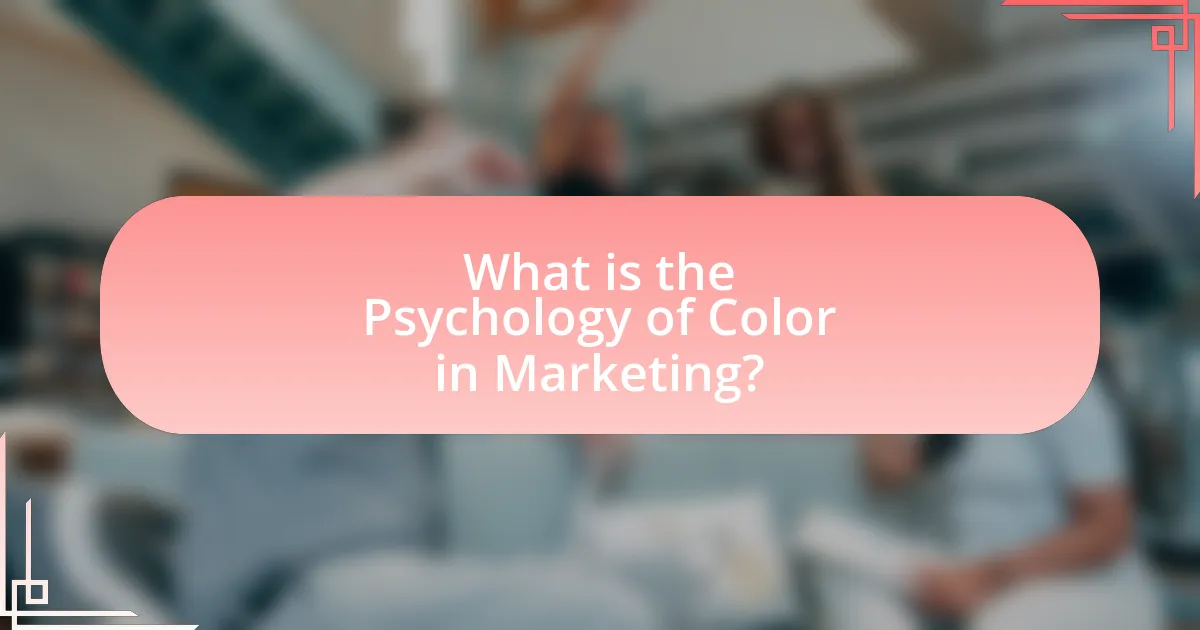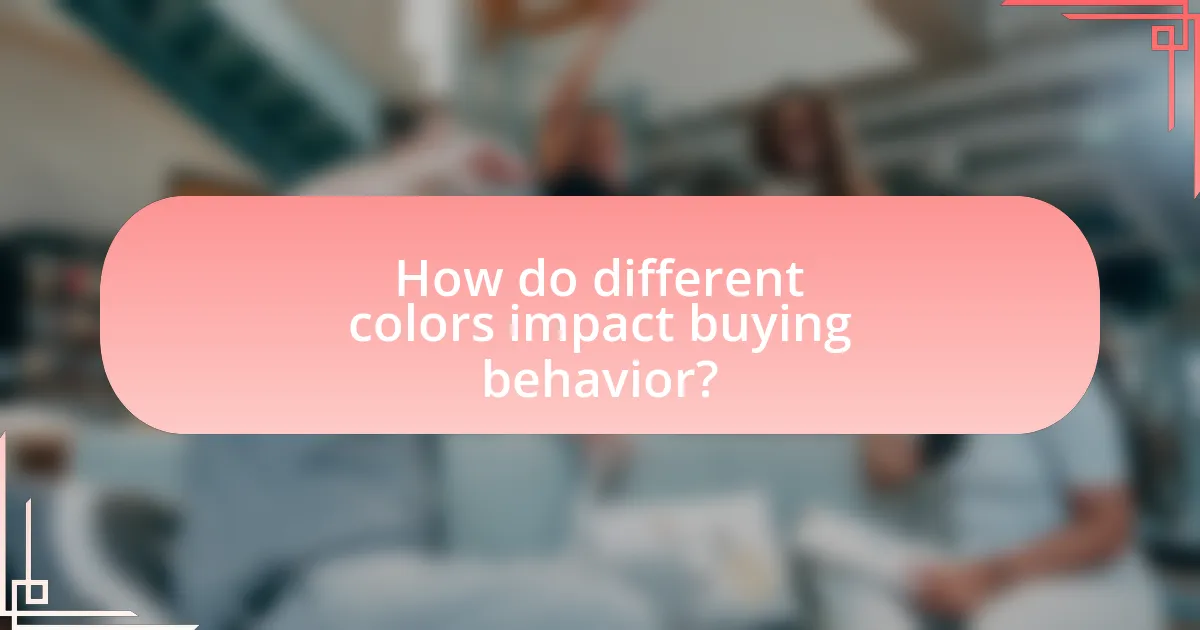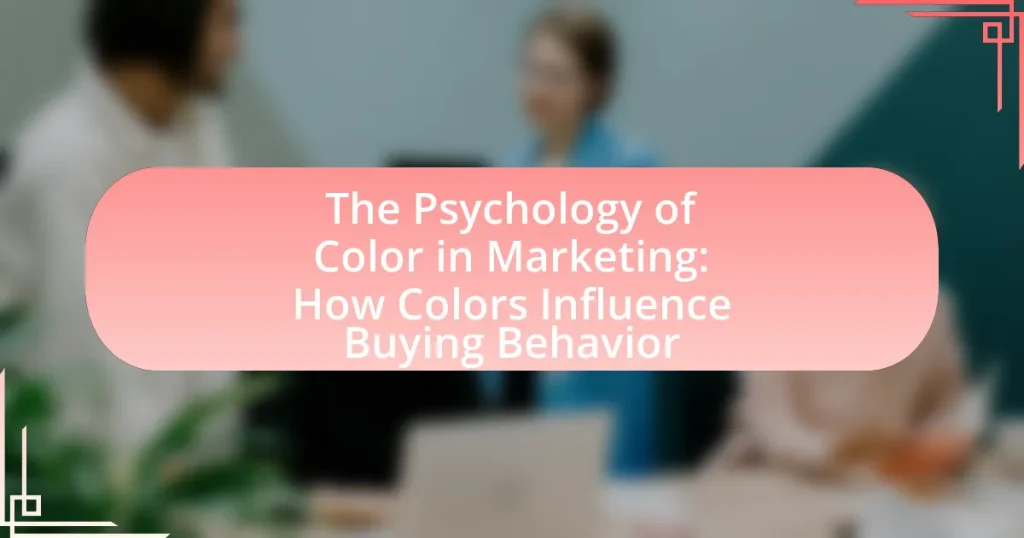The article explores the psychology of color in marketing, detailing how colors affect consumer perceptions and behaviors, ultimately influencing purchasing decisions. It highlights research indicating that up to 90% of snap judgments about products are based on color, emphasizing the emotional responses elicited by different hues. The article also examines psychological theories of color perception, cultural differences in color meanings, and the importance of color choice in branding and consumer loyalty. Additionally, it provides practical tips for marketers on selecting effective color palettes and testing color effectiveness to enhance marketing outcomes.

What is the Psychology of Color in Marketing?
The psychology of color in marketing refers to how colors influence consumer perceptions and behaviors, impacting their purchasing decisions. Research indicates that colors can evoke specific emotions and associations; for example, red often stimulates excitement and urgency, while blue conveys trust and calmness. A study by the Institute for Color Research found that up to 90% of snap judgments made about products can be based on color alone, highlighting its significant role in branding and marketing strategies.
How do colors affect consumer emotions and perceptions?
Colors significantly influence consumer emotions and perceptions by evoking specific feelings and associations. For instance, red often stimulates excitement and urgency, making it effective for clearance sales, while blue tends to convey trust and calmness, which is why many financial institutions use it in branding. Research by Satyendra Singh in the “Management Decision” journal indicates that up to 90% of snap judgments made about products can be based on color alone. This demonstrates that color not only affects emotional responses but also impacts purchasing decisions, as consumers are more likely to engage with brands that resonate emotionally through their color choices.
What psychological theories explain color perception?
Psychological theories that explain color perception include the Trichromatic Theory, the Opponent-Process Theory, and the Color Constancy Theory. The Trichromatic Theory, proposed by Thomas Young and Hermann von Helmholtz, posits that the human eye has three types of color receptors sensitive to red, green, and blue light, which combine to create the perception of various colors. The Opponent-Process Theory, developed by Ewald Hering, suggests that color perception is controlled by opposing pairs of colors: red-green, blue-yellow, and black-white, which explains phenomena such as afterimages. Lastly, the Color Constancy Theory explains how the perceived color of objects remains relatively constant under varying illumination conditions, allowing for consistent color recognition despite changes in lighting. These theories collectively provide a comprehensive understanding of how humans perceive color and its psychological implications, particularly in contexts like marketing, where color can significantly influence consumer behavior.
How do cultural differences influence color meanings?
Cultural differences significantly influence color meanings, as colors can evoke distinct emotions and associations based on cultural context. For example, in Western cultures, white is often associated with purity and weddings, while in many Eastern cultures, it symbolizes mourning and funerals. This divergence in color interpretation affects marketing strategies; brands must consider cultural perceptions to effectively communicate their messages. Research by the Institute for Color Research indicates that color increases brand recognition by up to 80%, highlighting the importance of aligning color choices with cultural meanings to enhance consumer engagement and purchasing decisions.
Why is color choice important in branding?
Color choice is important in branding because it significantly influences consumer perception and behavior. Research indicates that color can increase brand recognition by up to 80%, as colors evoke specific emotions and associations that can enhance brand identity. For example, blue is often associated with trust and reliability, making it a popular choice for financial institutions. This psychological impact of color on consumer decision-making is supported by studies, such as those conducted by the Institute for Color Research, which found that people make subconscious judgments about products within 90 seconds, with 62-90% of that assessment based solely on color. Thus, effective color selection in branding is crucial for establishing a strong market presence and influencing purchasing decisions.
What role does color play in brand recognition?
Color plays a crucial role in brand recognition by influencing consumer perceptions and emotions associated with a brand. Research indicates that color can increase brand recognition by up to 80%, as it helps create a visual identity that consumers can easily recall. For instance, brands like Coca-Cola and McDonald’s effectively use red and yellow, respectively, to evoke feelings of excitement and hunger, enhancing their memorability. This psychological impact of color is supported by studies, such as those conducted by the University of Loyola, which found that color increases brand recognition significantly, demonstrating its importance in marketing strategies.
How can color influence brand loyalty?
Color significantly influences brand loyalty by evoking emotional responses and creating strong associations with a brand. Research indicates that up to 90% of snap judgments made about products can be based on color alone, highlighting its power in shaping consumer perceptions. For instance, brands like Coca-Cola and Tiffany & Co. have successfully utilized specific colors—red and blue, respectively—to foster recognition and emotional connections, leading to increased customer loyalty. This emotional engagement is crucial, as consumers are more likely to remain loyal to brands that resonate with them on a psychological level, reinforcing the idea that color is a vital component in building lasting brand relationships.

How do different colors impact buying behavior?
Different colors significantly impact buying behavior by influencing emotions and perceptions associated with products. For instance, studies show that red can create a sense of urgency, often leading to impulse purchases, while blue tends to evoke feelings of trust and security, making it effective for brands aiming to establish credibility. Research conducted by the University of Loyola found that color increases brand recognition by up to 80%, highlighting its importance in consumer decision-making. Additionally, a study published in the Journal of Business Research indicates that consumers are more likely to purchase products that align with their emotional responses to colors, demonstrating the direct correlation between color choices and buying behavior.
What are the psychological effects of warm colors on consumers?
Warm colors, such as red, orange, and yellow, evoke feelings of warmth, excitement, and energy in consumers. These colors can stimulate emotions and encourage impulsive buying behavior, as they are often associated with feelings of comfort and enthusiasm. Research indicates that warm colors can increase heart rates and create a sense of urgency, which can lead to quicker purchasing decisions. For instance, a study published in the Journal of Consumer Research found that red can enhance appetite and increase the likelihood of food purchases, while yellow is often linked to happiness and optimism, further influencing consumer choices.
How do red and orange colors stimulate action?
Red and orange colors stimulate action by evoking strong emotional responses and increasing energy levels. Research indicates that red can raise heart rates and create a sense of urgency, making it effective for calls to action in marketing. For instance, a study published in the Journal of Consumer Research found that red enhances attention and encourages impulsive behavior, which can lead to quicker purchasing decisions. Similarly, orange is associated with enthusiasm and excitement, prompting consumers to take action. The combination of these colors in marketing strategies effectively drives engagement and motivates consumers to act.
What emotions do warm colors evoke in potential buyers?
Warm colors, such as red, orange, and yellow, evoke emotions of excitement, warmth, and urgency in potential buyers. These colors are often associated with feelings of happiness and enthusiasm, which can stimulate impulse buying behavior. For instance, research indicates that red can increase heart rates and create a sense of urgency, prompting quicker purchasing decisions. Additionally, warm colors can enhance feelings of comfort and friendliness, making consumers more receptive to marketing messages. This emotional response is supported by studies in color psychology, which show that warm colors can significantly influence consumer behavior and decision-making processes.
What are the psychological effects of cool colors on consumers?
Cool colors, such as blue, green, and purple, evoke feelings of calmness, tranquility, and trust in consumers. Research indicates that these colors can reduce anxiety and create a sense of relaxation, which may lead to longer shopping durations and increased likelihood of purchase. For instance, a study published in the Journal of Business Research found that blue environments can enhance feelings of security and reliability, positively influencing consumer behavior. Additionally, cool colors are often associated with professionalism and competence, making them effective in branding for industries like healthcare and finance.
How do blue and green colors create a sense of trust?
Blue and green colors create a sense of trust by evoking feelings of calmness and stability. Research indicates that blue is often associated with reliability and professionalism, making it a popular choice for financial institutions and healthcare brands. For example, a study published in the journal “Color Research and Application” found that blue enhances perceptions of trustworthiness in brands. Similarly, green is linked to health, tranquility, and nature, which fosters a sense of safety and reassurance. This connection is supported by findings from the “Journal of Environmental Psychology,” which show that green environments can reduce anxiety and promote feelings of well-being. Together, these colors effectively communicate trustworthiness and reliability in marketing contexts.
What calming effects do cool colors have on purchasing decisions?
Cool colors, such as blue and green, have calming effects that can positively influence purchasing decisions by reducing anxiety and creating a sense of tranquility. Research indicates that these colors evoke feelings of relaxation and trust, which can lead to a more favorable shopping experience. For instance, a study published in the Journal of Consumer Research found that consumers exposed to cool colors were more likely to perceive products as high-quality and were more willing to spend money, as these colors foster a peaceful environment that encourages thoughtful decision-making.

How can marketers effectively use color in their strategies?
Marketers can effectively use color in their strategies by aligning color choices with brand identity and consumer psychology. Research indicates that colors can evoke specific emotions and influence purchasing decisions; for example, red can create a sense of urgency, while blue often conveys trust and reliability. A study published in the journal “Management Decision” found that up to 90% of snap judgments made about products can be based on color alone. By understanding the psychological impact of colors, marketers can enhance brand recognition and drive consumer engagement, ultimately leading to increased sales.
What are best practices for selecting colors in marketing materials?
Best practices for selecting colors in marketing materials include understanding the target audience, aligning colors with brand identity, and considering color psychology. Research indicates that colors can evoke specific emotions and influence consumer behavior; for instance, blue often conveys trust, while red can create urgency. Additionally, maintaining color consistency across all marketing channels enhances brand recognition, as studies show that consistent branding can increase revenue by up to 23%. Therefore, marketers should carefully choose colors that resonate with their audience and reflect their brand values to effectively drive engagement and sales.
How can marketers align color choices with target audience preferences?
Marketers can align color choices with target audience preferences by conducting thorough research on the psychological impact of colors and understanding demographic characteristics. For instance, studies show that colors evoke specific emotions and associations; blue often conveys trust and reliability, while red can stimulate excitement and urgency. By analyzing the target audience’s age, gender, cultural background, and personal preferences, marketers can select colors that resonate with their values and emotions. Research from the Institute for Color Research indicates that people make a subconscious judgment about a product within 90 seconds, and 62-90% of that assessment is based on color alone. This data underscores the importance of strategic color selection in marketing to effectively engage and influence consumer behavior.
What tools can assist in choosing effective color palettes?
Tools that can assist in choosing effective color palettes include Adobe Color, Coolors, and Paletton. Adobe Color allows users to create color schemes based on color theory principles, offering options like complementary and analogous colors. Coolors generates color palettes quickly and allows for easy adjustments and exploration of different combinations. Paletton provides a visual interface for creating color schemes and previews how they will look in various contexts. These tools are widely used in design and marketing to ensure that color choices align with psychological principles that influence consumer behavior.
How can color testing improve marketing outcomes?
Color testing can significantly improve marketing outcomes by optimizing the emotional and psychological responses of consumers to brand colors. Research indicates that color can influence up to 90% of a consumer’s first impression of a product, affecting their purchasing decisions. For instance, a study by the Institute for Color Research found that people make a judgment about a product within 90 seconds of initial viewing, with color being a primary factor in that decision. By conducting color tests, brands can identify which colors resonate best with their target audience, leading to increased engagement, higher conversion rates, and ultimately, improved sales performance.
What methods can be used to test color effectiveness in campaigns?
A/B testing is a primary method used to test color effectiveness in campaigns. This method involves creating two versions of a marketing asset, such as an advertisement or webpage, where one version uses a specific color scheme and the other uses a different one. By analyzing metrics such as click-through rates, conversion rates, and user engagement, marketers can determine which color scheme performs better. Research indicates that color can influence purchasing decisions, with studies showing that up to 85% of consumers make purchasing decisions based on color alone. This highlights the importance of testing different color options to optimize marketing effectiveness.
How do A/B tests help in determining the best color choices?
A/B tests help in determining the best color choices by comparing two or more variations of a design to see which color option yields better performance metrics, such as conversion rates or user engagement. This method allows marketers to gather empirical data on how different colors affect consumer behavior, enabling them to make informed decisions based on actual user responses rather than assumptions. For instance, a study by HubSpot found that changing a call-to-action button from green to red increased conversions by 21%, demonstrating the significant impact color can have on user actions.
What practical tips can marketers apply regarding color usage?
Marketers can enhance their strategies by applying specific color usage tips that align with consumer psychology. First, they should understand that colors evoke emotions; for instance, blue often conveys trust, while red can create urgency. This knowledge allows marketers to select colors that resonate with their brand message and target audience.
Additionally, marketers should consider cultural differences in color perception; for example, white symbolizes purity in Western cultures but can represent mourning in some Eastern cultures. This awareness helps avoid miscommunication and strengthens brand connection.
Furthermore, using contrasting colors can improve readability and draw attention to key elements, such as calls to action. Research indicates that high contrast can increase visibility and engagement, making it essential for effective marketing materials.
Lastly, consistency in color usage across all platforms reinforces brand identity, as studies show that consistent branding can increase revenue by up to 23%. By implementing these practical tips, marketers can effectively leverage color to influence buying behavior.


